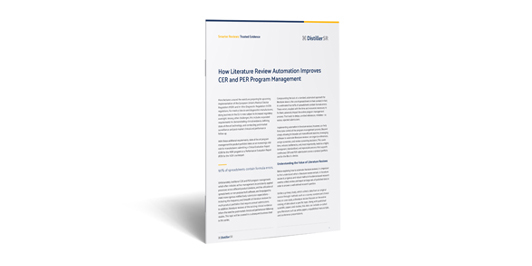Case Study
Geistlich Pharma Completes Literature Review Screening 85% Faster Than Manual Methods Using DistillerSR
DistillerSR enabled faster reference screening, reducing title and abstract screening time by 85% from nearly four minutes to 35 seconds per reference in the team’s first project.

Audit-Ready CER Submissions

Faster Literature Review Screening
AI-powered screening prioritized relevant references and dramatically decreased title & abstract screening time by 85% from nearly 4 minutes to 35 seconds per reference when compared to manual processes.

Repeatable, Configurable Processes
DistillerSR’s configurable platform generated custom templates and reusable forms, creating a reproducible literature review management process that can be replicated across a large medical device portfolio.
To meet the requirements of the European Union’s new Medical Device Regulation (MDR), Geistlich’s legacy medical devices require an annual clinical evaluation report (CER) submission to a notified body with an updated summary of safety and clinical performance (SSCP) data. Shelley Jambresic, Geistlich’s senior clinical evaluation manager, and her team of medical writers were using a combination of EndNote, Word, and Excel spreadsheets to conduct their literature reviews for these submissions. However, importing references into Excel spreadsheets and manually cleaning them up turned out to be an incredibly time-consuming and error-prone way of extracting data for CER submissions. They quickly realized that their records were unreliable and that the tools they were using were not robust enough to handle the task.
At the time, Shelley was planning the transition of four Class III legacy medical devices from the European Union’s old Medical Devices Directive (MDD) to the MDR. “The compliance process had become more complex with the MDR, and the amount of literature to be monitored for each device had increased substantially since their market launch,” said Shelley. “While reviewing our internal processes and doing research on how to improve our literature review completion times, I came across DistillerSR.”
Throughout the onboarding process with DistillerSR’s customer success team, Shelley and her team were able to configure the platform to match their project requirements. They created forms and templates to standardize inclusion and exclusion criteria and to simplify the data extraction stage of the literature review. “I was pleasantly surprised by how configurable and flexible the platform was,” said Shelley.
DistillerSR also enabled faster reference screening, reducing title and abstract screening time by 85% from nearly four minutes to 35 seconds per reference in the team’s first project.
DistillerSR’s automatic duplicate detection and removal helped the team at Geistlich streamline their literature searches and prevent potential bias caused by studies being mistakenly included more than once. Meanwhile, AI-powered screening enabled them to find relevant references faster and to start working on the later stages of the review sooner. According to Shelley, “DistillerSR learned my inclusion and exclusion pattern and reordered references based on relevance, which translated into a more efficient overall review process and faster completion rates.”
By learning my inclusion and exclusion pattern and reordering references based on relevance, DistillerSR’s AI enabled a more efficient overall review process and faster literature review completion rates.
Implementing DistillerSR was also an opportunity to build a central data archive for Geistlich’s medical device portfolio. In the past, the team’s clinical evaluations were not properly organized or documented, so they used the platform to build a data repository for each medical device, granting everyone involved in the project clean and clear access to historical data and the latest literature.
DistillerSR’s automated email reporting capability helped Shelley produce reference lists and reports to keep her supervisors regularly informed of the project’s progress.
The level of transparency that resulted from DistillerSR’s implementation was also welcomed by the entire organization. “When I introduced DistillerSR to my management team, my strongest argument was around auditability. Every entry and decision is tracked in the audit log, so you know exactly who did what and when. That’s a very powerful statement, especially when you’re dealing with potential red flags raised by auditors from notified bodies. Since fully deploying DistillerSR, I can answer any questions related to inclusion/exclusion decisions with confidence and transparency,” Shelley noted.
Six Months Later, a New Submission
Six months after the successful completion of the first project, Shelley and her team were ready to tackle a new one: the CER submission for their oldest legacy medical device. Introduced to the market in the 1980s, the device had decades of literature to review — the most of all their products. “Creating a literature search report for 3,500 references using EndNote, Word, and Excel would have been impossible. Not only would the tools not have been able to handle the task, but we, as humans, would not have had the cognitive ability to digest all those references manually. DistillerSR handled this new task effortlessly and the team was able to move to the data extraction stage of the review faster than ever before,” said Shelley.
Working with two medical writers located in Greece was possible thanks to DistillerSR’s cloud-based environment. Shelley was able to follow their progress in real time and easily resolve conflicts as they arose. The 3,500 references for title and abstract screening turned into 200 references for data extraction.
“I was able to conduct my review more accurately with DistillerSR. I trusted that those 200 references we ended up with in the data extraction stage were exactly the data we needed to focus on for our CER submission,” recalled Shelley.
The CER submission was completed after six months. Using DistillerSR, Shelley was able to present the data to the notified body in a structured manner, and the feedback was positive. “The literature review is the backbone of every regulatory submission. The notified body wants you to tell a clear story and present the data in a logical manner. If you check those boxes, you’re much more likely to receive your certification without raising any red flags,” said Shelley.
What’s Next? Even More Significant Time Savings with DistillerSR’s CuratorCR
Download the PDF version of this case study
Related Resources

Business Brief
Automated literature reviews provide greater levels of auditability and program management to CER and PER submissions.

Case Study
Dr. Bonnie H. Weiner describes the way DistillerSR reduced the time it took to complete CER literature reviews by approximately 30%.
Learn More About DistillerSR





